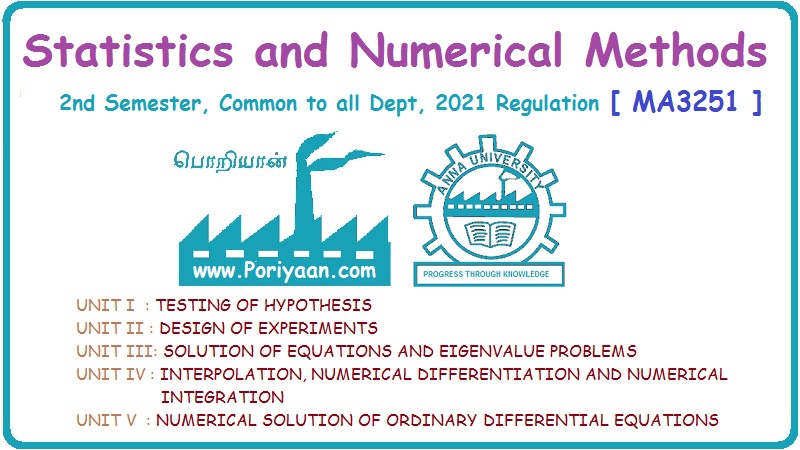Statistics and Numerical Methods: Unit II: Design of Experiments
Exercise 2.4 [Latin Square Design]
Solved Example Problems | Design of Experiments | Statistics
Statistics and Numerical Methods : Unit - II : Design of Experiments : Exercise 2.4
EXERCISE 2.4
1.
Four types of Health drinks A, B, C, D were tried on the school children. In
order to study the effects of the age groups of the children and localities,
four schools from four different localities, were selected and students were
divided into four age groups. The Latin Square design was arranged. The gain in
weights in same units are recorded below. Test whether the localities age
groups and the varieties of food have any significant effect on the gain in
weight. [A.U N/D 2011]

2.
A company appoints 4 salesmen A, B, C and D and observes their sales in 3
seasons: summer, winter and monsoon. The figure (in lakes of Rs.) are given in
the following table.

Carry
out an analysis of variance.
3.
An agricultural experiments was conducted on a latin square to investigate the
yield per acre of five different varieties of wheat, when subjected to treatment
of two types of fertilizers A and B, each of five different strengths. The
results are set out in Latin square below in which letters correspond to
varieties, columns are treated with different strengths of fertilizer A and
rows with different strengths of fertilizer B.

Discuss
the yield variations with respect to each of the factors. [A.U
Nov. 2005]
4.
Five varieties of paddy A, B, C, D and E were tried. The plan, the varieties
sown in each plot and yields obtained in kg are given in the following table.
(the net size of the plot being 5m × 6m, the whole experiment occupied an area
of 30 m × 40 m)

Test
whether there is significant difference between rows and columns at 5% level of
significance using ANOVA. [A.U June 2007]
5.
A set of children were divided into four equal groups and each group was given
from lists of words to test spelling ability. Each list formed one of four
different types of tests, A, B, C, D. The arrangement of experiment is given
below :
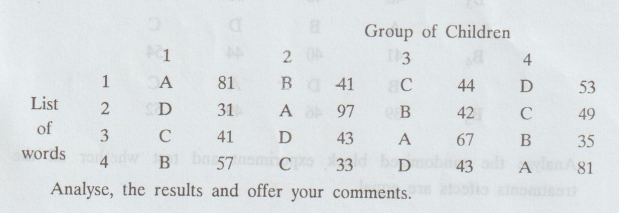
Analyse,
the results and offer your comments.
6.
The following data relate to the results of a Latin Square experiment of four
varieties of Paddy A, B, C, D.

Analyse,
the results and offer your comments.
7.
(i) What is a Latin Square Design ? What
are the considerations in the choice of r in an L.S.D. of order r?
(ii)
Under what conditions can this design be used?
(iii)
Give the assumptions and applications of an L.S.D. in field experimentations.
(iv)
Discuss briefly the advantages and disadvantages of a Latin Square Design.
(v)
Compare and contrast the Latin Square Design with the Randomised Block Design.
8.
Consider a randomized block experiment with 4 treatments A, B, C and D and 5
blocks. The observations are given below :

Analyse
the randomized block experiment and test whether all the treatments effects are
equal.
9.
(a) Give the mathematical model assumed in L.S.D. and explain the analysis of
variance table used for analysis the result of such an 2150 experimental
design.
(b) What are the advantages of Latin Square
Design compared to that of a Randomised Block Design.
10.
Fill in the blanks the following analysis of variance table of the L.S.D.
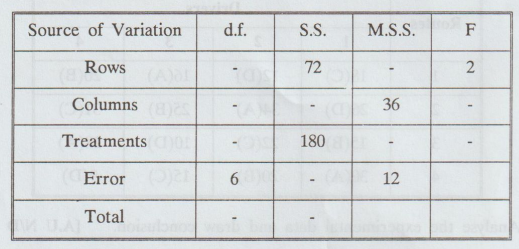
11.
An industrial experiment wishes to compare the effects of 4 types of grids A,
B, C and D on the vacuum of radio tubes. Sealing machines and operators are two
factors which may affect vacuum. Latin square experiment was concluded and the
following coded data was obtained :
Effects
of Types of Grids on the Vacuum of Radio Tubes
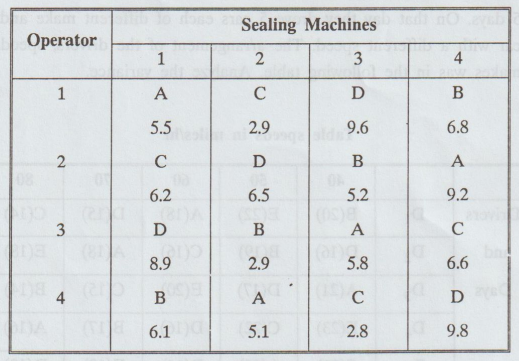
Analyse
the data and draw suitable conclusions.
12.
A company wants to produce cars for its own use. It has to select the nd make
of the car out of the four makes A, B, C and D available in the market. For
this they tries four cars of each make by assigning the cars to four drivers to
run on four different routes. The efficiency of car is measured in terms of
time in hours. The layout and the time consumed is as given below:

Analyse
the experimental data and draw conclusion.
13.
Gas consumption by different makes of modified cars for illustrating randomized
block designs, has been converted to one with 5 makes of modified cars to
illustrate Latin square design. The effects of day and driver on consumption
rate has been eliminated in addition to the effect of speed by suitable modification of the
experimental situation.
For
this 5 drivers were chosen and each driver was used on one of the 5 days. On
that day they drove 5 cars each of different make and each car with a different
speed. The arrangement of the drivers, speeds and makes was in the following
table. Analyze the variance.
Table
speeds in miles/hr

14.
An experiment was carried out to determine the effect of claying the ground on
the field of barley grains; amounts of clay used were as follows:
A:
No clay
B
: Clay at 100 per acre
C
: Clay at 200 per acre
D
: Clay at 300 per acre
The
yields were in plots of 8 metres by 8 metres and are given in the following
table:

Perform
an Anova and calculate the critical difference for the treatment mean yield.
15.
In a 5 × 5 Latin square experiment, the data collected is given in the matrix
below, yield per plot given in quintals for the five different cultivation
treatments A, B, C, D and E. Perform the analysis of variance.
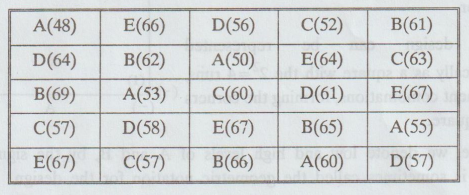
Statistics and Numerical Methods: Unit II: Design of Experiments : Tag: : Solved Example Problems | Design of Experiments | Statistics - Exercise 2.4 [Latin Square Design]
Related Topics
Related Subjects
Statistics and Numerical Methods
MA3251 2nd Semester 2021 Regulation M2 Engineering Mathematics 2 | 2nd Semester Common to all Dept 2021 Regulation
